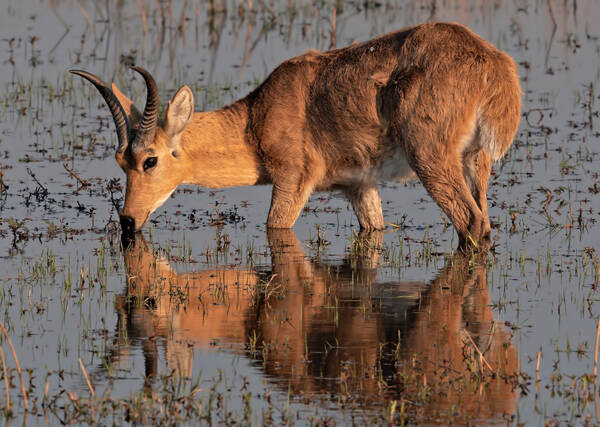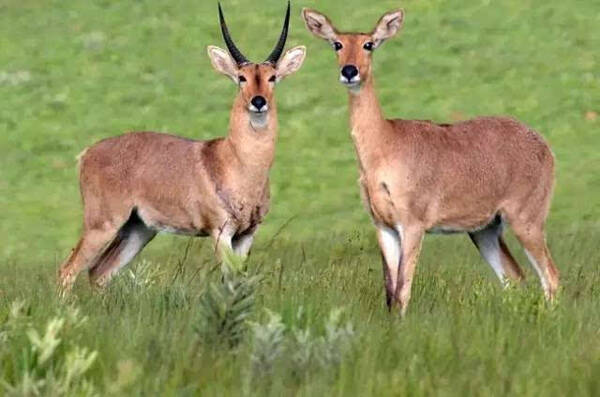Redunca arundinum
IUCN
LCBasic Information
Scientific classification
- name:Redunca arundinum
- Scientific Name:
- Outline:Ungulata
- Family:Artiodactyla Bovidae Reedbuck
Vital signs
- length:1334-167cm
- Weight:48-68kg
- lifetime:10-18years
Feature
The fur color varies widely, from light yellow-brown to gray-brown
Distribution and Habitat
Origin: Angola, Botswana, Democratic Republic of Congo, Eswatini, Gabon, Malawi, Mozambique, Namibia, South Africa, Tanzania, Zambia, Zimbabwe; Possibly extinct: Congo; Uncertain and wandering: Lesotho.
The southern reedbuck inhabits the humid areas of the savannahs of southern Africa. The northern limit of the range appears to be the edge of the woodlands. They are common in seasonally flooded valleys near the waters of the Ugalla River. The habitat consists of swampy areas with abundant water sources and tall grasses. The southern reedbuck occupies floodplains and floodplain grasslands in savanna woodlands. The most important habitats in South Africa are valleys with high grass cover (or suitable herbaceous cover) and permanent water sources, and they prefer grass islands and avoid areas of woody vegetation. The southern reedbuck in the Drakensberg Mountains of South Africa occurs between 1,800-2,000 meters above sea level. The species overlaps with the reedbuck in southern Tanzan
Appearance
The southern reedbuck is the largest of the three species of reedbuck. Males weigh an average of about 68 kg, and females weigh about 48 kg; the body length is 134-167 cm. The color of the fur of this species varies greatly, ranging from light yellow-brown to gray-brown. White fur covers the underparts and the area near the lips and chin. There are light brown stripes on the sides of the head and white rings around the eyes. There are white and black markings on the forelimbs. The underside of the tail is white and appears short and bushy. Only males have horns, which appear around the 6th month of the species' life. The horns are strongly ridged, 30-45 cm long, and form a "V" shape. They extend from the head, first pointing gently backwards, then curving upward and protruding at the tip. Both males and females have a bare gland under the ear.
Details
Southern Reedbuck (scientific name: Redunca arundinum) English Southern Reedbuck, French Redunca grande, Afrikaans Rietbok, German Grossriedbock, no subspecies.

The territory of female Southern Reedbuck is 15-40 hectares. Males maintain territories that include several females. Territory demarcation is not very clear and may overlap. The species marks its range using glands in the groin. Sometimes it also marks with its horns, which involves rubbing the horns and head between nearby vegetation, soil and shrubs.
The Southern Reedbuck is a semi-social animal. During the rainy season, when food and water are plentiful, they can be found in pairs or groups (males, females and young) or alone. In the winter, when food and water become scarce, solitary Southern Reedbuck are extremely rare. During the mating season, females begin to move around the territory. Although they are more social and may form temporary aggregations during the dry season, territories are formed and protected during the rainy season. The species usually forms small groups of 2-3 individuals. Most of them bask in the sun on sunny rocky slopes in winter, rest in the shade of trees or under rocky cliffs in summer, and often stay on isolated cliffs during other seasons. Old male southern reedbucks have their own territories, living with a single female and often accompanying her to avoid other competing males. Females and young male southern reedbucks are mostly solitary, except in the dry season when they gather in groups (about 20) due to need.
Southern reedbucks are active animals during the day, but become inactive during the heat of the day. Auditory and visual markings include prostrate, whistling, and displaying pride postures. When a male approaches a female in another male's territory, an upright posture is assumed. In addition, a slow and deliberate approach results in immediate surrender or attack. These physical confrontations are manifested by head butting and shoving with horns if the other male does not back off. Eventually, one of the males will jump away and the other male will strut and assume an upright posture to show his dominance.

Southern reedbucks have excellent hearing and use this as their primary defense strategy. They usually remain completely still, using camouflage to hide in tall grass. They stay until the threat is about 10 meters away, then jump up, flashing their white cotton tails as they leap.
The Southern Reedbuck is capable of a number of characteristic sounds, including a piercing whistle through the nostrils, and a distinctive "popping" sound caused by the inguinal gland when leaping. The whistle is made by expelling air from the nostrils. When whistling in a friendly manner, the Southern Reedbuck holds its head upright, ears forward, and tail hanging freely. When called in a startled or fearful manner, the Southern Reedbuck will either remain motionless with its ears and head erect, or arch its back violently, hoping to scare off an intruder it usually hasn't seen yet. When leaping or attacking, a popping sound is often heard, seemingly coming from the inguinal area, releasing scent markings.
The Southern Reedbuck feeds exclusively on grasses, weeds, and sedges. They occupy a specialized ecological niche by consuming grasses in relation to their own height. This greatly reduces competition. They seem to prefer young grasses and reed shoots, but are not restricted to them. The species only consumes leaves in winter when the nutritional value of grasses is greatly reduced. As a ruminant, nomadic movements are followed by a period of rumination lasting from a few minutes to an hour. Generally, the southern reedbuck is very dependent on water. During the dry season, southern reedbucks seen in Kruger National Park drink at least once a day and will not venture more than 1.5-2 kilometers away from water. It is a feeder mainly of fresh grass, but occasionally eats small amounts of shrubs, and may even forage for a wider range of species in some areas.

Southern reedbucks mate in late autumn and early winter, with males fighting with their horns or standing on their hind legs and fighting with their front legs to compete for females. The gestation period of females is about 6-8 months, with 1-2 calves born each time. The lactation period is 2 months. During mating, females perform a dance that includes a long upward-curved tail and a straight jump. With each jump, a scent is released from the inguinal pouch into the air, creating a popping sound. During courtship, the male examines the female's genitals and uses his nose to sample the female's urine, and then copulation occurs. The male protects the female from other males.
Southern reedbucks breed year-round, but peak between December and May. Typically, the gestation period is 7-8 months, with one calf born per litter. A few weeks before giving birth, the female leaves the male and drives away the calves of previous years. The calf weighs only 4.5 kg at birth and hides in the vegetation for about 2 months. During this time, the mother visits and cleans the calf once a day, usually for 10-30 minutes, and nurses it for the first few months of its life. After two months of hiding, the calf is with its mother, but it stays away from males for another 2 months. After this, the female leads the calf into the herd. Once the females are ready to give birth again, they will drive out their grown offspring, usually in their second year, while males can remain in their home range until adulthood (third year), when it is time for males to start looking for their own territories. Sexual maturity is reached at 1.5-2 years of age, with an average lifespan of 10-12 years, and up to 18 years in captivity.
The estimated total population of the southern reedbuck is about 73,000, of which about two-thirds live in protected areas. The trend of the species' population is generally stable in protected areas (60%), increasing on private land (13%), and decreasing elsewhere (27%). There is no evidence that the species is close to meeting the criteria for threatened or near threatened status. For the southern reedbuck to continue to be well protected in protected areas and private farms, their overall status should remain unchanged, although some outlying populations may face a more uncertain future, for example in Gabon, southern Congo and the Democratic Republic of the Congo.
Listed in the IUCN Red List of Threatened Species in 2016 ver3.1 - Least Concern (LC).
Protect wild animals and eliminate game.
Maintaining ecological balance is everyone's responsibility!








